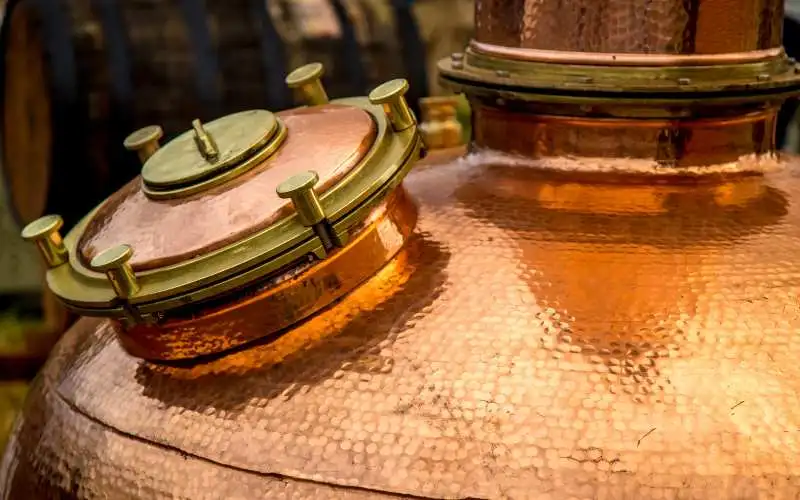Making moonshine, a traditional homebrew, is a fascinating and rewarding process that dates back centuries. Good Ol Moonshine emphasizes the importance of preserving this age-old craft while following the necessary guidelines. This guide will walk you through each step of the moonshine-making process, ensuring you have all the knowledge you need to create your own spirits at home. It’s crucial to understand the legalities involved in making moonshine, as distilling alcohol without the proper permits is illegal in many areas. Please ensure you’re aware of your local laws and always prioritize safety, a key focus for Good Ol Moonshine enthusiasts.
Essential Ingredients for Moonshine
Cornmeal
Cornmeal is a staple in many moonshine recipes due to its high starch content, which converts to sugars during fermentation. These sugars are then converted to alcohol by yeast. Cornmeal is readily available and affordable, making it a popular choice for many home distillers.
Why Cornmeal is a Popular Choice
Cornmeal provides a distinct flavor profile that many moonshine enthusiasts appreciate. Its starch content is ideal for fermentation, resulting in a high yield of alcohol.
Alternatives to Cornmeal
While cornmeal is popular, you can also use other grains like barley, rye, or wheat. Each grain imparts a different flavor to the final product, allowing for experimentation and variation in your moonshine.
Sugar
Sugar is another essential ingredient in moonshine production. It provides the necessary food for yeast during fermentation, leading to alcohol production.
The Role of Sugar in Fermentation
Sugar is broken down by yeast into alcohol and carbon dioxide. The type and amount of sugar used can significantly impact the flavor and potency of your moonshine.
Types of Sugar to Use
Common types of sugar used in moonshine making include granulated sugar, brown sugar, and cane sugar. Each type can influence the taste and texture of your final product.
Water
Water quality is crucial in moonshine making. It affects the taste and purity of your final product.
Importance of Clean Water
Using clean, filtered water ensures no contaminants affect the fermentation process or the flavor of your moonshine. Poor quality water can introduce unwanted flavors and impurities.
How Water Quality Affects the Final Product
High-quality water leads to a smoother, cleaner-tasting moonshine. Always use filtered or distilled water to maintain the purity of your spirits.
Yeast
Yeast is a microorganism responsible for converting sugars into alcohol during fermentation.
Types of Yeast Suitable for Moonshine
Bakers yeast, distillers yeast, and turbo yeast are commonly used in moonshine making. Each type has different alcohol tolerance levels and fermentation speeds.
How to Choose the Right Yeast
The choice of yeast depends on your desired alcohol content and fermentation speed. Distillers yeast is often preferred for its high alcohol tolerance and efficiency.
Equipment You’ll Need
Fermentation Vessel
A fermentation vessel is where the mash ferments, converting sugars into alcohol.
Types of Containers You Can Use
Plastic buckets, glass carboys, and stainless steel containers are all suitable for fermentation. Each has its pros and cons regarding ease of cleaning, durability, and cost.
How to Prepare Your Container
Sanitize your container thoroughly before use to prevent contamination. Use a food-grade sanitizer and ensure it’s completely dry before adding your mash.
Airlock
An airlock allows gases to escape during fermentation while preventing contaminants from entering.
Purpose of an Airlock
The airlock maintains an anaerobic environment, essential for fermentation, by allowing carbon dioxide to escape and keeping oxygen and contaminants out.
Different Types of Airlocks
There are several types of airlocks, including three-piece airlocks and S-shaped airlocks. Choose one that fits your fermentation vessel and is easy to clean.
Distillation Apparatus
The distillation apparatus is crucial for separating alcohol from the fermented mash.
Components of a Distillation Setup
A typical distillation setup includes a pot still or column still, a condenser, and a collection container. Each component plays a role in ensuring efficient and safe distillation.
Safety Considerations When Using Distillation Equipment
Always distill in a well-ventilated area and monitor the temperature closely to prevent accidents. Never leave the distillation process unattended.
Measuring Tools
Accurate measurement of ingredients and alcohol content is vital in moonshine making.
Hydrometers and Thermometers
Hydrometers measure the specific gravity of your mash, helping you monitor fermentation progress. Thermometers ensure your mash and distillation temperatures are optimal.
How to Use These Tools Effectively
Calibrate your hydrometer and thermometer before use. Regularly check your mash’s specific gravity and temperature to ensure a successful fermentation and distillation.
Storage Containers
Proper storage containers are essential for aging and preserving your moonshine.
Best Materials for Storing Moonshine
Glass jars, stainless steel containers, and oak barrels are ideal for storing moonshine. Each material offers different aging and flavoring benefits.
How to Properly Clean and Sterilize Storage Containers
Clean your storage containers with a food-grade sanitizer and rinse thoroughly. Allow them to air dry completely before use to avoid contamination.
The Fermentation Process Explained
Preparing the Mash
Creating a quality mash is the foundation of good moonshine.
Step-by-Step Guide to Making the Mash
- Mix Cornmeal and Water: Combine cornmeal and water in your fermentation vessel. The ratio of water to cornmeal is typically 4:1.
- Heat the Mixture: Heat the mixture to around 160°F to gelatinize the starches, making them easier to convert to sugars.
- Add Sugar: Once cooled to around 100°F, add sugar and mix thoroughly.
- Cool the Mash: Allow the mixture to cool to room temperature before adding yeast.
Common Mistakes to Avoid
Avoid overheating the mash, as it can kill the yeast. Ensure the mash is thoroughly mixed to prevent uneven fermentation.
Adding the Yeast
Pitching yeast correctly is crucial for a successful fermentation.
How to Properly Pitch the Yeast
Sprinkle the yeast evenly over the cooled mash. Stir gently to incorporate the yeast without introducing too much oxygen.
Signs of a Healthy Fermentation
Bubbles in the airlock and a foamy cap on the mash indicate active fermentation. A healthy fermentation should begin within 24-48 hours.
Monitoring Fermentation
Keeping an eye on your fermentation process ensures it proceeds smoothly.
How Long Fermentation Takes
Fermentation typically takes 1-2 weeks, depending on temperature and yeast activity.
What to Look for During the Process
Regularly check the airlock for bubbling and the mash for any off smells, which can indicate contamination.
Troubleshooting Fermentation Issues
Even with careful preparation, issues can arise during fermentation.
Common Problems and Their Solutions
- No Bubbling: Check if the temperature is too low or if the yeast is dead.
- Off Smells: This could indicate contamination. In severe cases, you may need to start over.
How to Know If Your Mash is Ready for Distillation
The mash is ready when bubbling has stopped, and the specific gravity remains constant for a few days.
Distillation: Turning Mash into Moonshine
Setting Up Your Still
Proper setup is critical for safe and efficient distillation.
Detailed Instructions on Setting Up a Still
- Assemble the Still: Ensure all connections are tight and secure.
- Add the Mash: Pour the fermented mash into the still.
- Heat the Mash: Gradually heat the mash to around 173°F.
Safety Tips to Prevent Accidents
Never leave the still unattended and always distill in a well-ventilated area to avoid the risk of explosions or fires.
Running the Still
Distillation is the process of separating alcohol from the mash.
Step-by-Step Process of Distillation
- Heat the Mash: Slowly bring the mash to a boil.
- Collect the Distillate: Collect the alcohol vapors as they condense.
- Monitor Temperature: Keep the temperature steady to ensure consistent distillation.
Importance of Temperature Control
Maintaining the right temperature ensures you separate the alcohol efficiently and avoid burning the mash.
Collecting the Distillate
Collecting the different fractions of distillate is crucial for a high-quality product.
How to Collect Different Fractions
- Foreshots: Discard the first 5% of the distillate.
- Heads: Collect and discard the next 30%—contains volatile alcohols.
- Hearts: Collect the middle 30-40%—the purest part.
- Tails: Collect the remaining distillate—contains heavier compounds.
Understanding the Differences Between These Fractions
Foreshots contain harmful compounds, heads have undesirable flavors, hearts are the best quality, and tails contain fusel oils.
Testing Purity and Proof
Ensuring your moonshine is safe and potent is essential.
How to Measure the Alcohol Content
Use a hydrometer or alcoholmeter to measure the alcohol content of your distillate.
Tools Needed for Testing
A proof and tralle hydrometer measures the alcohol content accurately. Ensure it is calibrated correctly for precise readings.
Aging and Storing Your Moonshine
Aging Moonshine
Aging can significantly enhance the flavor of your moonshine.
Methods of Aging Moonshine
- Barrel Aging: Age your moonshine in an oak barrel to add complexity.
- Jar Aging: Use glass jars with wood chips to mimic barrel aging.
How Aging Affects Flavor
Aging allows the moonshine to mellow, develop depth, and gain subtle flavors from the wood.
Flavored Moonshine
Adding flavors can make your moonshine unique and enjoyable.
Adding Flavors During the Aging Process
Add fruits, spices, or herbs to your moonshine during aging to infuse flavors.
Popular Flavoring Techniques and Recipes
- Apple Pie Moonshine: Add apple cider, cinnamon sticks, and sugar.
- Peach Moonshine: Add peach slices and vanilla beans.
Storing Your Final Product
Proper storage is key to preserving your moonshine’s quality.
Best Practices for Long-Term Storage
Store your moonshine in a cool, dark place. Use glass containers with tight seals to prevent oxidation.
How to Avoid Contamination and Spoilage
Ensure all storage containers are sterilized and sealed properly. Avoid plastic containers, as they can leach chemicals into the alcohol.
Conclusion
Making moonshine is a rewarding and intricate process that combines art and science. By following this step-by-step guide, you can create high-quality moonshine safely and legally. Remember to always prioritize safety, understand the legal implications, and enjoy the process responsibly. Experiment with different ingredients and techniques to find your perfect recipe and share the joy of homebrewing with others.
ABOUT

Hey, Mark Ladd here. I am a sports fanatic and have a passion for this. Particularly running is what I love best. However, around 5 years ago I had an accident that changed my life. I can no longer pursue those sporting activities, so I moved my focus on a different approach where I blog about the sports and other areas of life which I have grown to appreciate more since my accident.
Click to read on


